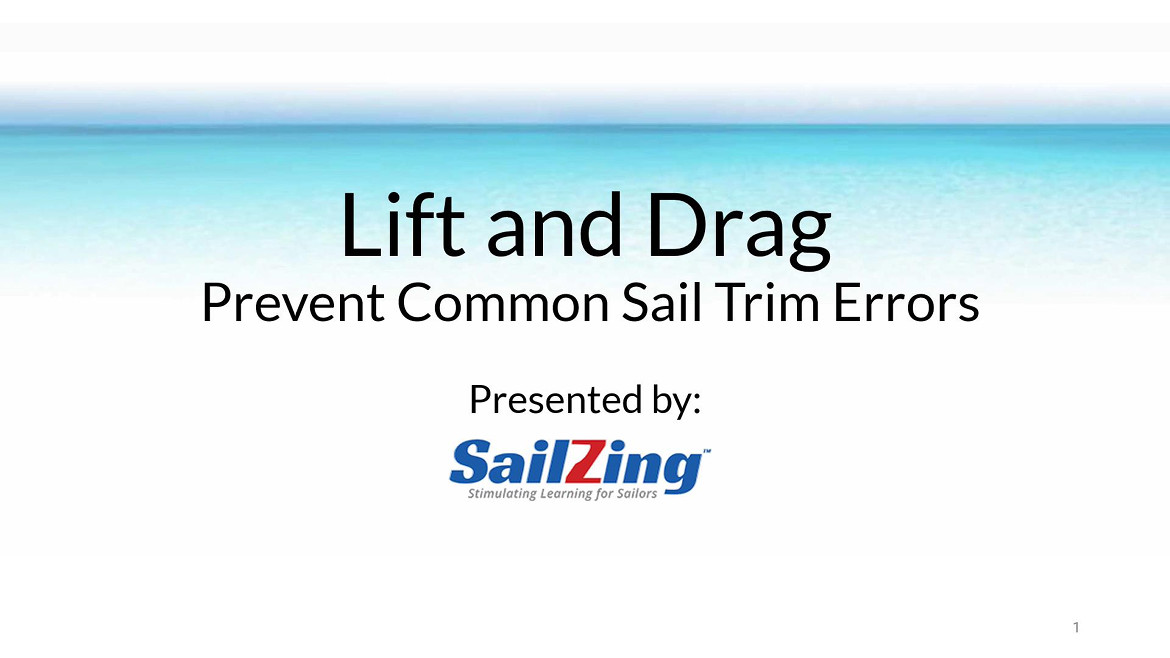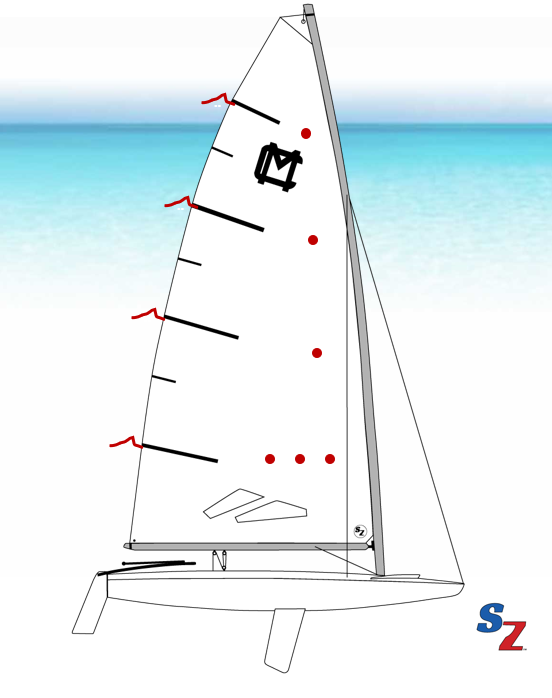You need a huge range of mainsheet tension to be fast in all conditions, especially in boats with bendy masts. – anonymous fast scow sailor
Want to go faster upwind? Your biggest opportunity may be to pay more attention to mainsheet tension, adjusting the main with every change in wind. Many sailors are lazy with their mainsheet, maintaining a medium tension and steering with the rudder to power up and depower. Working your mainsheet constantly is a better way to stay powered up, pointing high, and sailing the boat on its lines.
Am I Lazy with my Mainsheet?
If you are slow and can’t point, the answer is probably yes. For sure, the answer is yes if you:
- cleat the mainsheet upwind
- don’t have a strong grip or don’t tax your strength during a moderate to windy race
- never approach block-to-block in your mainsheet trim on moderate to windy days
- see other people hiking while you’re just sitting on the rail
- don’t use at least several feet of mainsheet as your range of sheeting upwind in a typical puffy race
- aren’t making constant small adjustments in mainsheet tension
Power Up
As a relatively new sailor, I had an “Aha” moment when sailing next to Andy Burdick before a race in a medium breeze. I was to windward and even with him, but was pointing lower and going slower. Andy looked over and said, “Sheet harder and hike.” I did, and things got a little better, but Andy looked at my sail and said, “Harder.” That did the trick, and the instant reward of being able to keep up with a top sailor (if only for a few moments) stuck with me.
Are you fully powered up? Here are some indications:
Feel
This should always be your first indicator. Many sailors sheet in until the boat feels powered up, but stop there. Once you think you are powered up, try a little more mainsheet tension. If the boat responds (heels a little more or feels more lively), that’s a good thing. If not, ease back.
Dave Dellenbaugh confirms this technique in Speed and Smarts, Issue 114 (quotes used with permission):
My philosophy about the mainsheet is that I always try to trim it harder. This, of course, depends a lot on feel. If the boat feels good (pressured up and going fast through the water), then I trim harder. If the boat starts to feel not so good (slowing down, straightening up), I ease the sheet a little to get the boat going. Then I try trimming harder again and the cycle repeats itself.
If you trim in and this makes the boat feel better (more lively, more heel, but not overpowered), then you probably did the right thing and you can try trimming even more. But if you trim harder and the boat feels worse (more mushy and less lively), then you may have gone too far.
Upper Leech – Top Batten and Telltales
When the wind is light to medium, use the upper leech of the sail as a trim guide. Sheet in until the top batten is parallel to the boom and the leech telltales are “active,” alternately streaming back and disappearing behind the sail. Many expert sailors speak of trimming using the leech. For more, see The Leech is the Thing (Sailing World), which is an excerpt from Tom Whidden’s book, The Art and Science of Sails.
Don’t Sail Soft in Heavy Air
As the breeze comes up, if you can’t hold the boat down, don’t compensate by sailing soft, with main eased and luffing. Keep your main sheeted in as much as possible, hike hard, pull on your controls to flatten the sail, and drop your traveler. This will take a lot of mainsheet tension, and you may find you need to strengthen your grip to handle it.
Adjust Constantly
Every change in wind speed requires a change in mainsheet tension to maintain optimal trim. You may have heard the expression about mainsheet tension that goes, “When in doubt, let it out.” This is the yin to the yang of powering up. If you are powered up in light to medium air and the wind decreases, the leech will close (top batten will twist to windward). Now you are sheeted in too far and you need to ease the main to let the sail “breathe.”
The range of tension between light and heavy air can be huge, depending on how much the mast bends. On an MC Scow, in medium to heavy air, you can sheet in until the blocks on the boom are only a few inches above the block on the traveler. In light air, they might be two feet apart.
Puffs – Feather/Ease, Hike, and Trim
Another laziness indicator is “limp” reaction to puffs. Frank Bethwaite is an evangelist on this topic. He characterizes the “natural” (i.e., slow) sailors as those whose mainsheet hand remains immobile during puffs. These slow sailors try to handle the puff by luffing and hiking. His books, Fast Handling Technique and Higher Performance Sailing, describe the fast sailor’s response in detail.
Ease Rapidly
When a puff hits, the direction and speed of the apparent wind change instantly. So, you must change your sail trim instantly to match. This means easing immediately, since the apparent wind will move aft during a puff. Be ready to stop easing as soon as the boat can handle the puff without heeling up. You might ease the main as little as a few inches or as much as a few feet.
For more on apparent wind and how it changes in a puff, see Understanding Apparent Wind: Visual Resources (SailZing).
Hike
Obviously, you need to hike harder during the puff to help keep the boat on its lines.
Feather Up Slightly – Simultaneously
As the puff hits, you will feel the boat want to turn to windward, even if you ease the sheet. Instead of pulling on the tiller to hold your heading, let the tiller creep to leeward 3 to 5 degrees. This is “feathering.” Don’t overdo this – it should not feel like you are “steering up.” Feathering works with easing to match the boat’s heading and sail trim to the new apparent wind. It also helps you make progress to windward.
Some experts say to feather only after you have built speed by easing and hiking. Bethwaite comes down strongly on the side of feathering simultaneously with your ease. Just be sure that feathering is small and smooth and does not turn into luffing and and excess rudder movement.
Trim
This is another opportunity to avoid laziness. As soon as the puff begins to dissipate and the boat starts to roll to windward, sheet back in. If the roll back to windward is pronounced, sheet in aggressively to remain powered up. If necessary, also bear off slightly and get your body weight back in to keep the boat on its lines.
For more on the response to puffs, read Bethwaite’s books, or this article: Sail Faster with Less Hiking – Part 3: Gust and Lull Management from the International Laser Class Association.
Related Content:
MC-Scow Sailing Speed Guide Plus Drills
Sailing Lulls Tips – Part II: Trim In and Feather Down
Puff Response: Variations on Ease, Hike, Trim
Sailors Helping Sailors
Will you share your knowledge with your related Comments below?






This is an incredibly informative article on a high impact topic.